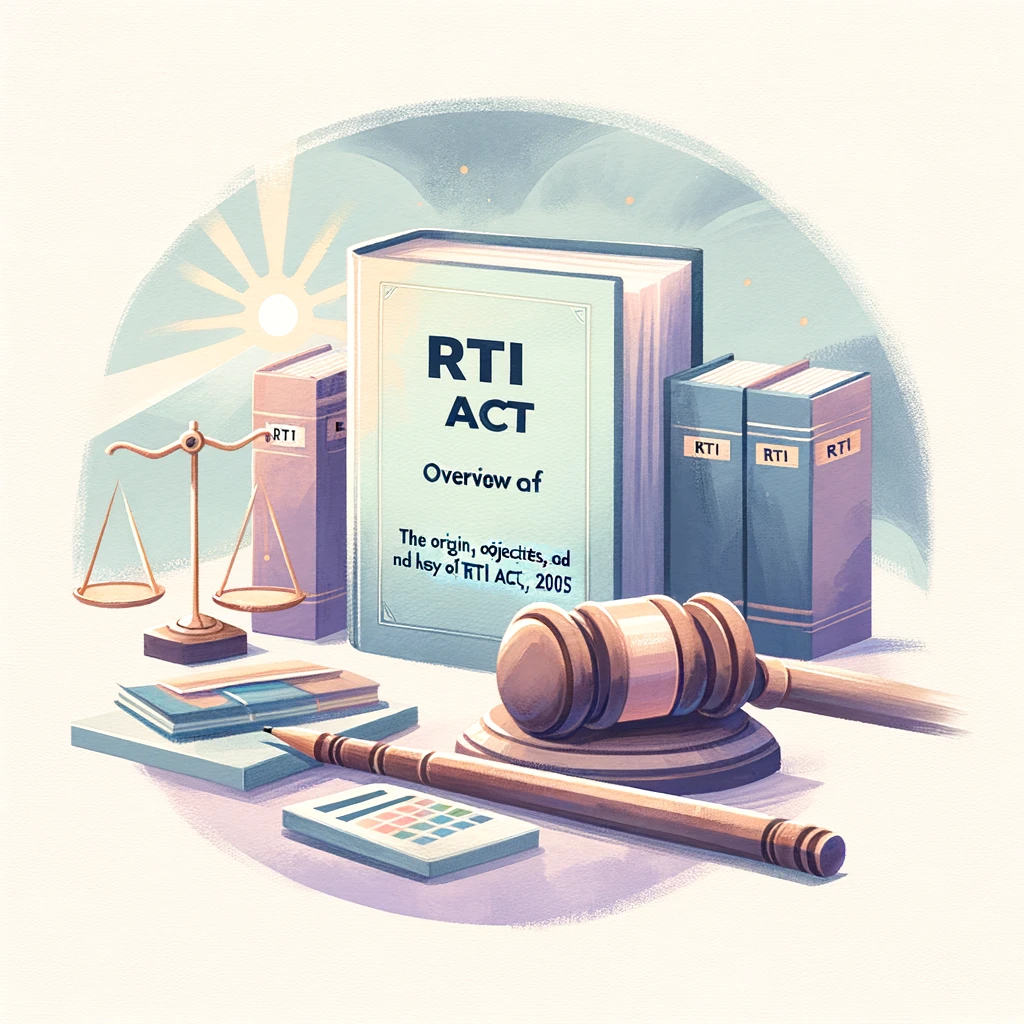The Right to Information (RTI) Act, of 2005, is a landmark piece of legislation in India that aims to promote transparency and accountability in government functioning. It empowers citizens to seek information from public authorities, thereby making the government more open and responsive to the needs of the people.

Overview of RTI Act
Origin and Objectives:
The RTI Act was enacted by the Indian Parliament on June 15, 2005, and came into full force on October 12, 2005. The Act’s primary objective is to empower citizens by ensuring access to information held by public authorities. Thereby promoting transparency, accountability, and good governance. It seeks to create an informed citizenry capable of holding the government accountable for its actions and decisions.
Key Provisions:
- Right to Access Information: Any citizen can request information from a public authority, which is required to respond within 30 days.
- Public Authorities’ Obligations: Public authorities are mandated to maintain records and proactively publish certain categories of information.
- Exemptions: Information affecting national security, personal privacy, and other specified areas is exempt from disclosure.
- Central and State Information Commissions: These bodies are established to oversee the implementation of the Act and address appeals and complaints.
- Penalties for Non-Compliance: Penalties can be imposed on public information officers (PIOs) for failing to provide information or for providing incorrect information.

Implementation and Challenges
Implementation Process:
The implementation of the RTI Act involves several steps. Public authorities appoint PIOs responsible for receiving and processing RTI applications. Information Commissions at the central and state levels act as appellate bodies and oversee the functioning of the RTI Act. Regular training and awareness programs are conducted to educate both government officials and the public about their rights and duties under the Act.
Challenges:
- Administrative Burden: The sheer volume of RTI applications can overwhelm public authorities, leading to delays in response.
- Lack of Awareness: Many citizens, especially in rural areas, are unaware of their rights under the RTI Act.
- Inadequate Record-Keeping: Poor record-keeping practices in some public offices hinder the effective provision of information.
- Resistance from Officials: Some officials may be reluctant to disclose information due to a lack of transparency culture or fear of exposure.
- Safety of RTI Activists: There have been instances where RTI activists have faced threats and violence. Thus highlighting the need for better protection mechanisms.
Success Stories
Increased Transparency and Accountability:
- Exposing Corruption: RTI applications have uncovered numerous corruption cases. For example, in the state of Bihar, an RTI query revealed a large-scale embezzlement of funds meant for flood relief, leading to significant administrative action.
- Public Service Delivery: In Delhi, RTI applications have been instrumental in improving public services like water supply and sanitation. Citizens used RTI to hold the municipal authorities accountable for the poor conditions in their localities.
- Empowerment of Marginalized Sections: In Maharashtra, tribal communities used RTI to access information about government schemes intended for their welfare. It had not reached them due to bureaucratic delays and corruption.
Comparison with Global Practices
Global RTI Laws:
- Freedom of Information Act (FOIA) – USA: Enacted in 1966, the FOIA allows for the full or partial disclosure of previously unreleased information controlled by the U.S. government.
- Freedom of Information Act (FOI) – UK: Implemented in 2000, the FOI Act provides public access to information held by public authorities, subject to certain exemptions.
- Sweden’s Public Access to Information Act: One of the oldest, dating back to 1766, emphasizing extensive transparency in government.
Comparison:
India’s RTI Act is considered one of the most progressive and comprehensive. However, with strong provisions for timely response and penalties for non-compliance. However, unlike Sweden, where transparency is deeply ingrained in the culture. India faces challenges related to bureaucratic resistance and implementation efficiency.
Future Prospects and Reforms
Enhancing Effectiveness:
- Strengthening Information Commissions: Ensure adequate staffing, resources, and training to handle the increasing volume of appeals and complaints.
- Improving Record-Keeping: Implement modern record management systems across all public authorities to facilitate easy retrieval of information.
- Raising Awareness: Conduct widespread awareness campaigns. Especially in rural and marginalized communities, to educate citizens about their rights under the RTI Act.
- Ensuring Safety of Activists: Implement robust protection measures for RTI activists, including legal and physical protection mechanisms.
- Technological Integration: Promote the use of digital platforms for filing RTI applications and tracking their status to enhance accessibility and efficiency.
The Right to Information Act has significantly impacted governance in India by promoting transparency and accountability. While there are challenges in its implementation, continued reforms and public awareness can further strengthen its role in empowering citizens and ensuring good governance.



